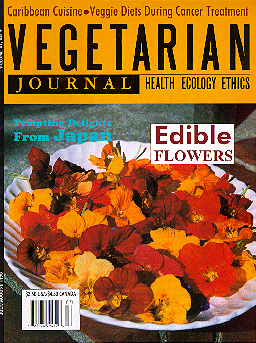
Vegetarian Journal
Excerpts
July/August 1996Volume XV, Number 4


|
Vegetarian JournalExcerptsJuly/August 1996Volume XV, Number 4
|

|
QUESTION:
Why is there so much confusion about the calcium content of tahini? Do you know the true milligram level? D.B, Ontario, Canada
ANSWER:
When I got ready to answer your question, I couldn't imagine what the confusion could be. The 15th Edition of Jean Pennington's Food Values of Portions Commonly Used says that one tablespoon of tahini contains 64 milligrams of calcium, alittle more than that contained in an orange. For comparison: one half cup of boiled broccoli contains 89 milligrams of calcium, as does one cup of canned pinto beans. Unfortunately, I then learned that the Home and Garden Bulletin #72, published by the USDA and revised in 1981, lists the calcium content of tahini as 21 milligrams in one tablespoon. Big discrepancy. Since there are three teaspoons in one tablespoon, I wondered if Bulletin #72 might have contained a typo, and that tablespoon should have been teaspoon instead. Not wanting to assume anything, I decided to check with the USDA. Here's your answer: The USDA has different data for the nutritional content of tahini, depending upon the way in which the sesame seeds were processed. The calcium content of "sesame butter, tahini" as listed in the USDA's Handbook 8, Section 12 (revised in 1984) refers to tahini made from roasted and toasted kernels. One tablespoon contains 64 milligrams of calcium. The Home and Garden Bulletin #72 gives a figure of 21 milligrams of calcium in one tablespoon of tahini made from unroasted kernels. Another USDA specification, for tahini made with "raw and stone ground kernels," is 63 milligrams of calcium in a tablespoon. Most nutrient data bases use Handbook 8 as their source of nutrition information; so information for tahini will usually refer to the "roasted and toasted" variety. One ounce of toasted sesame kernels (hulled seeds) contains 37 milligrams of calcium, whereas one ounce of whole, toasted and roasted seeds contains a whopping 281 milligrams of calcium. Now to complicate matters even more: the hull of the sesame seed contains a large amount of calcium relative to the kernel; that's why tahini made with whole seeds has more calcium than tahini made with hulled seeds. However, further discussion with the staff at the USDA's Nutrient Data Laboratory revealed that the calcium in the hull is present as calcium oxalate. Oxalates have been shown, in laboratory tests, to reduce the body's absorption of calcium. Does this mean that the calcium from whole-seed tahini is not well-absorbed? Is tahini, in fact, a good source of calcium for vegetarians or not? Connie Weaver, Ph.D., a nutrition scientist and department head at Purdue University, has conducted a considerable amount of research on calcium absorption rates from numerous plant foods. However, she is not aware of any research on the absorption rates of calcium from sesame seed hulls. I also spoke with Nancy Siebert at the National Institutes of Health's National Center for Nutrition. Nancy took a pragmatic approach to the question: "Twenty-one milligrams versus 64 milligrams, big deal! We never really know what the true absorption rate is for specific nutrients in any food. It depends upon too many factors. Besides, tahini is mostly fat, so it's not as if people would want to eat lots of it anyway." Nancy's point is well taken. Nutrients in foods interact with each other, and the absorption of any nutrient depends, in part, upon the foods that are eaten with it and the nutrients and other substances those foods contain. It also depends upon the body's need for the particular nutrient. Our bodies can adapt to varying dietary conditions; when we need more of many nutrients, the body may compensate and become more efficient at absorbing them. The bottom line: the calcium content of tahini varies, and the amount you absorb will depend upon multiple factors anyway. Look at tahini as being a reasonably-good source of calcium, but don't plan to rely on it as the primary source. Stick to some good overall principles of meal planning: eat a variety of foods, including plenty of vegetables, fruits, legumes, and whole grains. Get enough calories to meet your energy needs, and limit the sweets and fatty junk foods that displace more nutritious foods from your diet. Follow these common-sense guidelines, and most nutrition issues will fall into place. |
Thanks to volunteer Jeanie Freeman for converting this article to HTML
|
||||
| Last Updated September 20, 1997 |
Graphic design by | 
|
||
| The contents of this web site, as with all The Vegetarian Resource Group publications, is not intended to provide personal medical advice. Medical advice should be obtained from a qualified health professional. Any pages on this site may be reproduced for non-commercial use if left intact and with credit given to The Vegetarian Resource Group. Web site questions or comments? Please email brad@vrg.org. |
||||